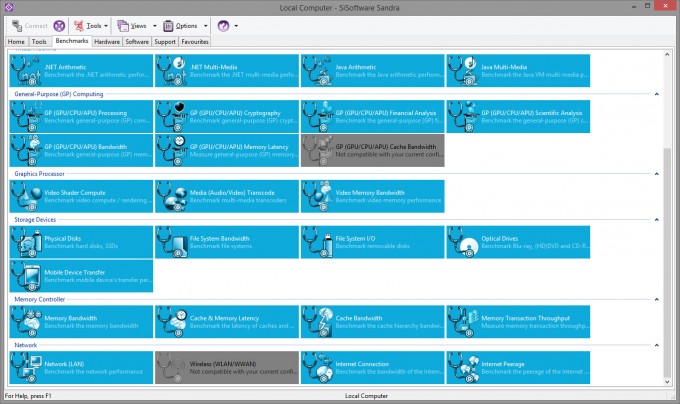- Qualcomm Launches Snapdragon 4 Gen 2 Mobile Platform
- AMD Launches Ryzen PRO 7000 Series Mobile & Desktop Platform
- Intel Launches Sleek Single-Slot Arc Pro A60 Workstation Graphics Card
- NVIDIA Announces Latest Ada Lovelace Additions: GeForce RTX 4060 Ti & RTX 4060
- Maxon Redshift With AMD Radeon GPU Rendering Support Now Available
Core i7-5960X Extreme Edition Review: Intel’s Overdue Desktop 8-Core Is Here

In late 2011, I wagered that Intel would follow-up its i7-3960X with an eight-core model within the year. That didn’t happen. Instead, we have had to wait nearly three years since that release to finally see an eight-core Intel desktop chip become a reality. Now for the big question: Was the company’s Core i7-5960X worth the wait?
Page 7 – Mathematics: Sandra Arithmetic, Multimedia, Cryptography & Financial
SiSoftware’s Sandra is a piece of software that needs no introduction. It’s been around as long as the Internet, and has long provided both diagnostic and benchmarking features to its users. The folks who develop Sandra take things very seriously, and are often the first ones to add support to the program long before consumers can even get their hands on the product.
As a synthetic tool, Sandra can give us the best possible look at the top-end performance from the hardware it can benchmark, which is the reason we use it to test much of our PC’s hardware. The fact that a free version exists so that you can also benchmark against our results is something we greatly appreciate.
The more threads a CPU has coupled with its frequency and architecture refinements, the faster it should be able to calculate complex math. We’re not talking about simple math that can be done on a calculator, but rather advanced calculation that is often used behind the scenes. Sandra’s Arithmetic test stresses the popular Dhrystone integer and Whetstone floating-point algorithms that have acted as a base for a countless number of benchmarks dating back as far back as the 70s.
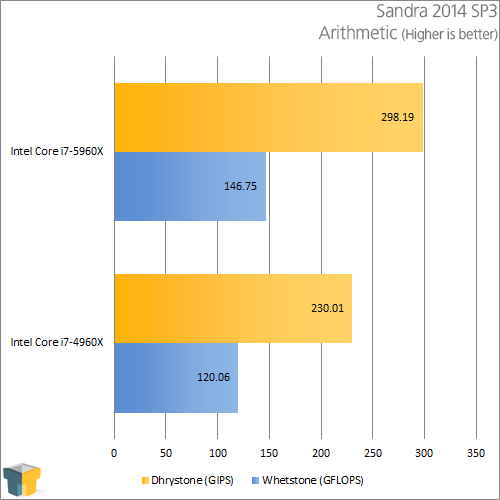
As I mentioned earlier, if a test is able to take proper advantage of a full eight-core processor, then chances are good that we’ll see up to a 33% speed advantage on this eight-core i7-5960X. That said, while gains so far do scale like that in this first Sandra test, we’ll have to settle with a 29.5% performance gain, rather than 33%, due to the lower clock speed. Even so, it goes without saying that performance gains close to 30% are impressive – remember our match-up between the i7-3960X and i7-4960X? At least here, we’re seeing gains worth getting excited about.
Sandra Multi-Media
One of the best reasons for upgrading or building a new PC is to increase the performance for multi-media work, whether it be editing or encoding. As we saw earlier in our results, faster CPUs can save minutes or even hours of time. To test such capabilities here, Sandra renders the famous Mandelbrot set in a total of 255 iterations and in 32 colors.
This is a test that’s been around for close to forever, but it still scales extremely well with thread counts and can benefit from new media-centric instruction sets, including AVX.
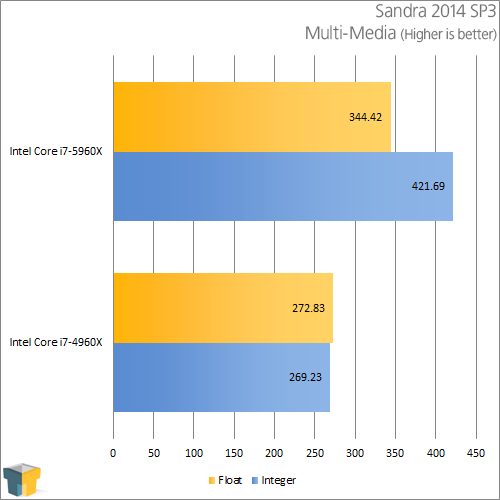
We see proof of the extra cores in the Float test, with a gain in performance of about 26%, but in the Integer test, we see proof of substantial design improvements, with a staggering gain of 56%.
Sandra Cryptography
You might not be aware of it, but cryptography plays a major role in computing. With some algorithms proving more complex than the others, having a faster processor can dramatically improve performance – especially important on the server front. In Sandra’s benchmark, the mega-popular AES and SHA algorithms are computed, both with 256-bit key sizes.
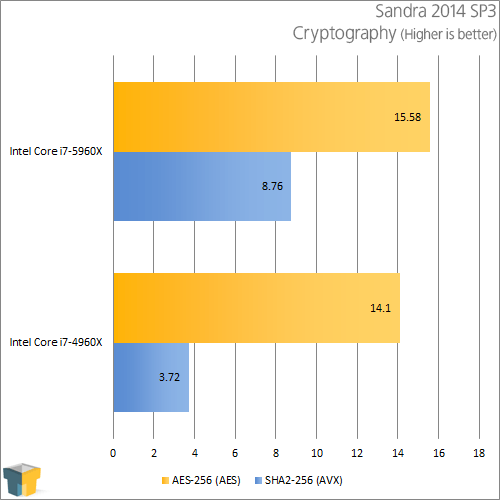
Here’s a test that makes me regret not being able to retest the i7-4770K for the sake of this review. With Haswell, Intel’s introduction of AVX2 instructions made a substantial difference in SHA hashing performance – about +50% in SHA-256. Well, I think it’s safe to say that with Haswell-E’s brawn behind this benchmark, the results are simply incredible when compared to the i7-4960X – we’re talking a performance gain of 2.35x. I suppose the 10% gain seen with AES-256 is also impressive, but anyone who’s built an Intel rig over the past four years has already been enjoying great AES performance.
Financial & Scientific Analysis
There’s little that can stress a CPU’s worth quite as much as number-crunching, and for that reason, we take full advantage of both Sandra’s financial and scientific analysis benchmarks.
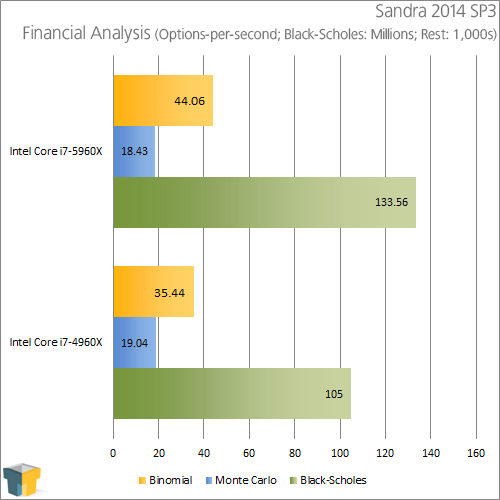
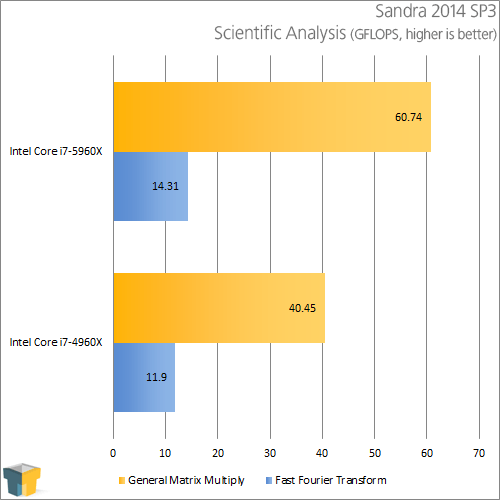
We’re seeing at least 20% gains here, with 25% being more typical. In the GEMM test of the scientific analysis benchmark, we see an enormous gain in performance of 50%. I admit, I find gains like that to be exciting, especially since Intel wasn’t going to let additional cores be the sole reason for gains.
Support our efforts! With ad revenue at an all-time low for written websites, we're relying more than ever on reader support to help us continue putting so much effort into this type of content. You can support us by becoming a Patron, or by using our Amazon shopping affiliate links listed through our articles. Thanks for your support!




